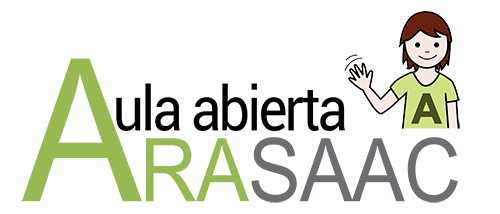Research and scientific studies carried out on the pictographic symbols of ARASAAC
 2015 - Preliminary study on the "Formal characteristics and transparency of the ARASAAC pictographic symbols"
2015 - Preliminary study on the "Formal characteristics and transparency of the ARASAAC pictographic symbols"Authors
Francisco Cabello Luque, Elisabetta Bertola López
Faculty of Psicología, Universidad de Murcia (España)
Summary
The iconicity and transparency of the ARASAAC pictographic symbols are examined, and compared with that of other sets of already established signs (SPC and Bliss).
 2015 -Thesis on "Formal characteristics and transparency of the pictographic symbols of ARASAAC" (2015)Author of the Thesis
2015 -Thesis on "Formal characteristics and transparency of the pictographic symbols of ARASAAC" (2015)Author of the ThesisElisabetta Bertola López
Thesis Director
Francisco Cabello Luque
Faculty of Psicología, Universidad de Murcia (España)
Summary
 2017 - Preliminary study "Auditory-visual support for grammatical development in intellectual disability" with ARASAAC pictogramsAuthors
2017 - Preliminary study "Auditory-visual support for grammatical development in intellectual disability" with ARASAAC pictogramsAuthorsManuela Miranda Fernández
Oviedo University
Verónica Martínez López
Oviedo University
José Manuel Agra Castro
CPEE Castiello (España)
Oral communication
XIV International Congress on Inclusive Education, XXXIV Conference on Universities and Inclusive Education.
Oviedo, April 3-5, 2017.
Summary.
Research on language in intellectual disability (ID) is currently focused from the notion of “syndromic specificity” and contrasts the linguistic profiles of different genetic syndromes, revealing that grammatical competence can be severely affected in some of them. Various studies show that hearing-based language learning is compromised in ID and that the acquisition of vocabulary and grammar is determined by their poor short-term verbal memory capacity. However, vocabulary and grammatical production increase when it is accompanied by visual material.
The objective of this work is to determine if a simultaneous auditory-visual support intervention program improves the language of subjects with ID, regardless of whether or not they present a genetic syndrome, increasing sound recognition, vocabulary and grammatical production.
 2018 - Study on the "Iconicity and ease of learning of the ARASAAC pictographic symbols"
2018 - Study on the "Iconicity and ease of learning of the ARASAAC pictographic symbols"Authors
Francisco Cabello Luque, Cristina Mazón Morillas
Faculty of Psicología, Universidad de Murcia (España)
Summary
In previous research by Bertola (2017) and Cabello and Bertola (2015) it was found that the ARASAAC pictograms had a high index of iconicity and, in fact, were more transparent than those of the SPC and Bliss sets. This finding was also replicated in the adult population, the child population with typical development, and the child population diagnosed with autism spectrum disorder.
The importance of high iconicity lies in its relationship with greater ease of learning. However, in these studies it was not possible to verify whether the ARASAAC symbols were actually easier to learn, and therefore the general objective of this work was the ease of learning the set of the ARASAAC, SPC and Bliss pictographic symbols in minors with developmental disorders.
 2018 - Preliminary study on "Pragmatic intervention in children and adolescents with Down syndrome: the role of supports in the construction of scripts" - "Pragmatic intervention in children and adolescents with Down syndrome: The role of support in script construction"Authors
2018 - Preliminary study on "Pragmatic intervention in children and adolescents with Down syndrome: the role of supports in the construction of scripts" - "Pragmatic intervention in children and adolescents with Down syndrome: The role of support in script construction"AuthorsManuela Miranda
Verónica Martínez
Eliseo Diez-Itza
Oviedo University
Raquel Rodríguez
Down Principado de Asturias
Poster presented at the World Down Syndrome Congress, WDSC 2018 Glasgow, United Kingdom, July 25-27, 2018.
 Preliminary study "Normative data on transparency of ARASAAC pictograms: study with adult population"
Preliminary study "Normative data on transparency of ARASAAC pictograms: study with adult population"Authors
M. Ángeles Alonso Rodríguez Jonathan W. Roldán Coya, Beatriz Viera Delgado
University of La Laguna (Spain)
Summary
The use of pictograms is common in work or therapy with people with complex communication needs (NCC), as well as in many situations in the daily life of many people. This study tries to obtain data from the ARASAAC graphic symbols by analyzing their transparency to achieve a standardized database with a normal population. In this study 41 adults participated, to whom 548 stimuli were presented per individual, out of the 1,644 total, which they had to assess on a 7-point scale based on their transparency. The results indicate that the pictograms used can elucidate efficiently.
 2020 - Scientific article on "Simultaneous auditory-visual support in grammatical intervention in participants with intellectual disabilities" with ARASAAC pictograms
2020 - Scientific article on "Simultaneous auditory-visual support in grammatical intervention in participants with intellectual disabilities" with ARASAAC pictogramsAutoras
Manuela Miranda Fernández
Verónica Martínez López
Oviedo University
Summary
Studies of language profiles in intellectual disability (ID) show that grammatical competence is affected in some genetic syndromes. Research on language learning in ID reveals that the role of hearing is compromised, that vocabulary and grammar acquisition is determined by poor auditory memory capacity, and that visual material facilitates the recognition of sounds, vocabulary, and grammar.
Objectives:
To determine whether simultaneous auditory-visual support improves language by increasing sound recognition, vocabulary, and grammar, and to analyze whether subjects with ID with a higher level of verbal age and auditory memory obtain better scores in sounds, vocabulary, and grammar after the intervention.









